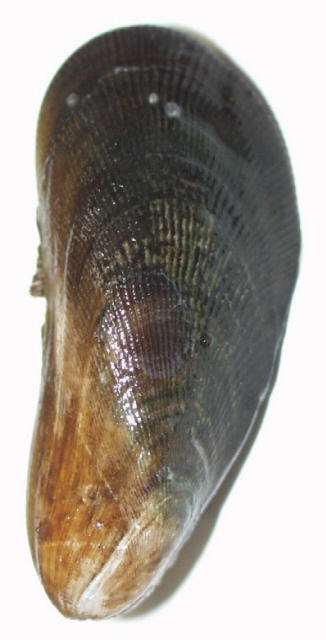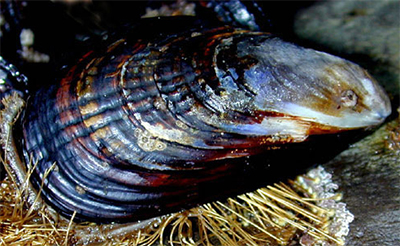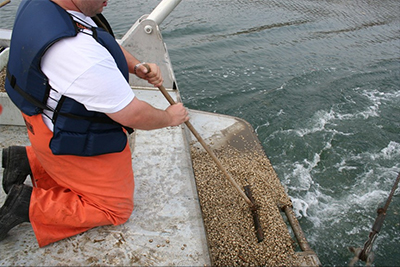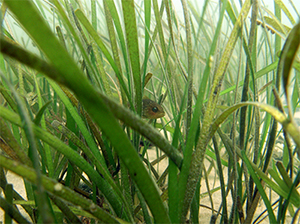Aquaculture Restoration Projects
Bio-Filtration
FLUPSY (Floating Upweller Systems)
Eelgrass Restoration
Village of Northport Sustainable Fisheries (Bio-Filtration) Proposal
 |
Water quality in Northport Harbor is heavily impacted by the buildup of nitrogen and other nutrients entering from point sources, runoff and subsoil infiltration. Northport seeks to use the natural salt water filtration qualities of ribbed mussels to remove excess nutrients and has asked NYS Department of Environmental Conservation for a permit to culture mussels for the purposes of water purification and shoreline stabilization. |
Bio-Filtration
 |
Ribbed Mussel
Geukensia demissa
|
The Atlantic Ribbed Mussel (Geukensia demissa) is a bi-valve mollusk of the family Mytilidae, a mussel species native to the Atlantic coast of North America. Characterized by its deep grooves, the female shell is medium brown in appearance, while the male is a lighter yellowish-cream.
Many bivalves feed through siphons that draw in water. Mussels, in contrast, feed by opening the shell slightly so the cilia hairs on the gills can draw in water and nutrients--usually algae and plankton--both nitrogen absorbing organisms. The feeding mussels capture the nitrogen in their own bodies and store it in their shells and body tissue. This and the ability to grow in dense clusters make the ribbed mussel an excellent bio-filtration agent.
Water bodies like Long Island Sound, where runoff from sewage treatment, fertilizers and other sources has caused excessive nitrogen build up, suffer from a condition known as eutrophication. Nutrients stimulate damaging algal blooms that lead to hypoxia (oxygen depletion) that threaten marine life as the algae die and decompose.
 |
Blue Mussel
Mytilus edulis
|
Mussels remove pollutants from the water breaking the eutrophic cycle and unlike such culinary delicacies as oysters, clams and blue mussels, people find the taste of the Atlantic ribbed mussel unpleasant. This trait mitigates the concern that once harvested from polluted waters ribbed mussels will end up being sold for human consumption.
Scientists are exploring ways to use harvested ribbed mussels as animal feed and fertilizer, but must be careful to ensure against uses that might return the nitrogen to impacted water bodies.
FLUPSY
Town of Huntington uses a technology known as a Floating Upweller System (or FLUPSY) to culture seed shellfish that are later transplanted Huntington’s harbors and bays. In addition to the role shellfish play in Long Island’s economy, a health shellfish population is integral to the health of the native LI marine ecosystem.
 |
| FLUPSY: juvenile oysters ready for transplanting. |
As its name indicates, FLUPSY is a floating nursery, consisting of seed containers, or silos. In Huntington’s case, silos are attached to floating piers at Gold Star Battalion Beach, where the seedlings are bathed in a continual flow of oxygenated water and nutrients in the form of phytoplankton (microscopic algae).
The pumped in oxygen and nutrient bath promotes fast, dense, uniform growth while the silos protect the young shellfish from predators. When the shellfish grow to the range of a half inch they are large enough to be planted in certified waters where they can grow to maturity and be safely harvested for consumption.
Eelgrass (Zostera Marina)

|
| Eelgrass (Long Island Sound Study) |
Eelgrass is an aquatic grassy flowering plant that grows in intertidal and sub-tidal zones of shallow coastal waters. People sometimes confuse eelgrass with salt marsh grass (Spartina), but marsh grass is ridged and stands upright leaving it visible even at high tide. Eelgrass, if visible, can be seen only at low tide when the leaves of the tallest shoots pierce the surface and lay flat on the water.
The buoyancy of Eelgrass in the water column makes it a fertile "nursery" for juvenile shellfish and other marine species at a crucial stage in their life cycles, offering protection and a place to feed.
As a flowering plant, Eelgrass uses photosynthesis to grow, a process during which nutrients and sunlight are converted into energy and oxygen is released as a by-product. Because the growth occurs underwater, the nutrient source—nitrogen in the water column—is removed and replaced with dissolved oxygen, a cycle vital to the health of marine ecosystems. In addition, the root structure of eelgrass stabilizes and oxygenates the mud and sandy bottom sediments.
Once prevalent up and down the Atlantic and Pacific coastlines, Eelgrass has suffered a severe die off over the past century, attributable to a variety of natural and man-made causes.
In 2005, Cornell Cooperative Extension in cooperation with Huntington's Department of Maritime Services began an Eelgrass and Bay Scallop restoration project at two Huntington sites, including one within the Northport Bay Complex at Winkle Point on Eaton's Neck. The project consisted of two sets of plantings, one within the Winkle Point "sluice" pond and the second in open bay water, where shoots and seedlings from Shinnecock Bay and Orient Point root stock were planted.
Dispite strong initial growth, late summer temperatures in the sluice pond rose above 90º—too high for the Eelgrass to survive. The bay samples also succumbed. Marine scientists hope to identify alternative restoration locations within the Northport Bay Complex should additional Eelgrass restoration funding become available.
